Alibaba Conundrum at Griffin Art Projects
11 February 2024By Ido Radon

What more can be written about what has already been said? Before these fingers so much as touched the keyboard, the discourse ran thick around Alibaba Conundrum, an exhibition at Griffin Art Projects by an artist duo of the same name. So many words had been said and written by the artists Ali Ahadi and Babak Golkar, curator Lisa Baldissera, and invited panel respondents, that even the gallery checklist was layered with further descriptions and explications beyond the usual fare.
Alibaba Conundrum is the artist collective made of Ali Ahadi and Babak Golkar, two Iranian-Canadian artists based in Vancouver. The moniker “Alibaba” is a riff on both the international commerce platform alibaba.com and “Ali Baba and the 40 Thieves,” a folk tale commonly included in translations of One Thousand and One Nights. It was not one of the original stories, but was added by French translator Antoine Galland into his 18th century translation. Thus, Alibaba can be read as a symptom of a colonial mindset (the translator’s overreach) and alibaba.com as a symptom and engine of globalization, both symptomatic of global capitalism’s evolving and unending need for perpetual growth.
The central work in the show is 10 + (-5) Commandments (2022), a single-channel video essay that makes its argument via a montage of cultural references that provoked a kind of gotta-catch-‘em-all response in the viewer. The work starts with a fiction concerning the rediscovery of an additional five commandments that, unlike the original Ten Commandments, are written in “The Old English.” The newly discovered commandments are “Read It,” “Say It,” “See It,” “Have It,” and “Amass It.”
Many of the other works in the show are stills from this video, such as The Origin of the World (2021), its title borrowed from Courbet’s notorious painting, but here applied to a blown-up and pixelated still image depicting a child’s hands covering their doll’s eyes. This image is lifted from a scene from the documentary film Here and Elsewhere (1976) by Jean-Luc Godard and Anne-Marie Miéville. 15 Commandments (The Origin of the Word) (2022) is a print depicting an image of Mel Brooks as Moses holding out three tablets from his 1981 comedy film History of the World. Puns and visual jokes abound for viewers who are quick enough to get the references.
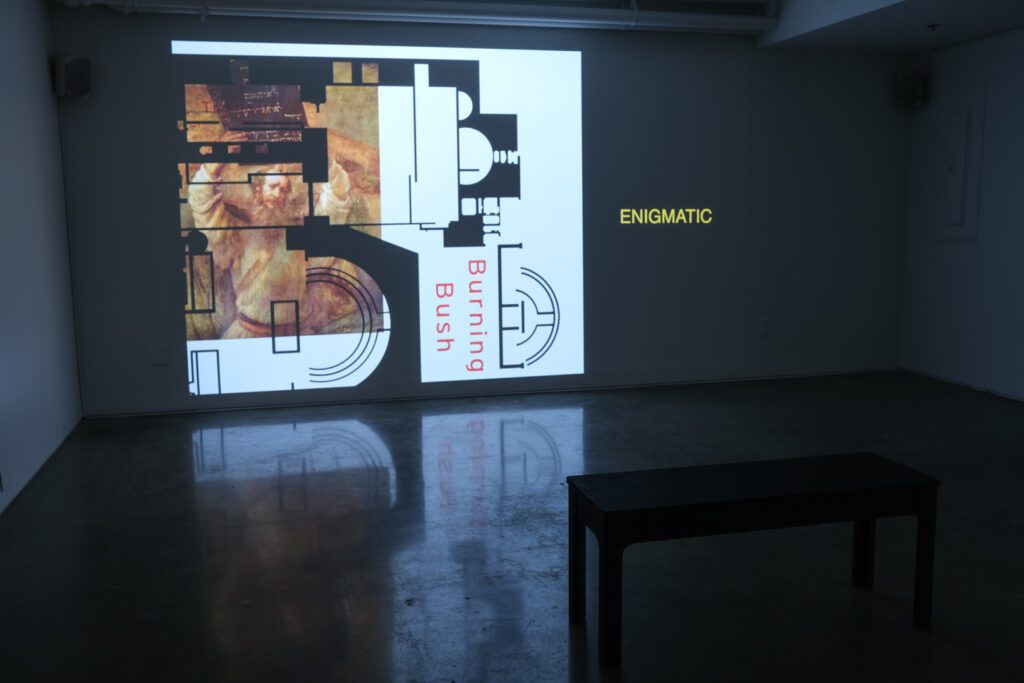
An earlier sequence in the video exemplifies Ahadi and Golkar’s successful use of free associative play as method. A floorplan of a church with a space labeled “burning bush”—the purported site of a biblical event in Sinai, Egypt—is depicted in the video with an image of Bush House (the old headquarters of the BBC’s World Service) in London with the words: “To the friendship of English Speaking Peoples” carved in stone above its doors. The scene then cuts to an Oval Office address by former US President George Bush (unrelated to the Irving of Bush House). Bush’s face then dissolves slowly to that of the barmaid in Édouard Manet’s provocative painting A Bar at the Folies-Bergère (1882), which posits the young woman on display as a commodity, a thing among other things on offer. The narrator reports that the third “tablet” was found on May 1, 2003, which in reality, was the date of George Bush’s “Mission Accomplished” speech declaring victory in the Iraq war.1
My takeaway from the work: mix capitalism and the newly minted bourgeoisie, Abrahamic religions, English as lingua franca, shake well, and, as Lee Ving sings in FEAR’s hardcore punk song, “Let’s have war!” (Which wasn’t one of the video’s many pop cult references, for the record.)
In another sequence, he who would “say it,” is exhorted by the narrator to use the “mic” which leads into a chant of “MIC check” (an Occupy reference)2 then slips into the acronym for the “military-industrial complex” (via a screen grab of its Wikipedia entry),3 a phrase coined by former US President Dwight D. Eisenhower, and his speech of the same name, in which he notes the potential for the “disastrous rise of misplaced power.”4 Footage of Eisenhower is sandwiched between images of performance artists Marina Abromovic and Ulay, both naked, who stand facing one another impassively in their performance Imponderabilia (1977). This image in particular was likely included more for its title, one imagines, than for the content of the performance itself.
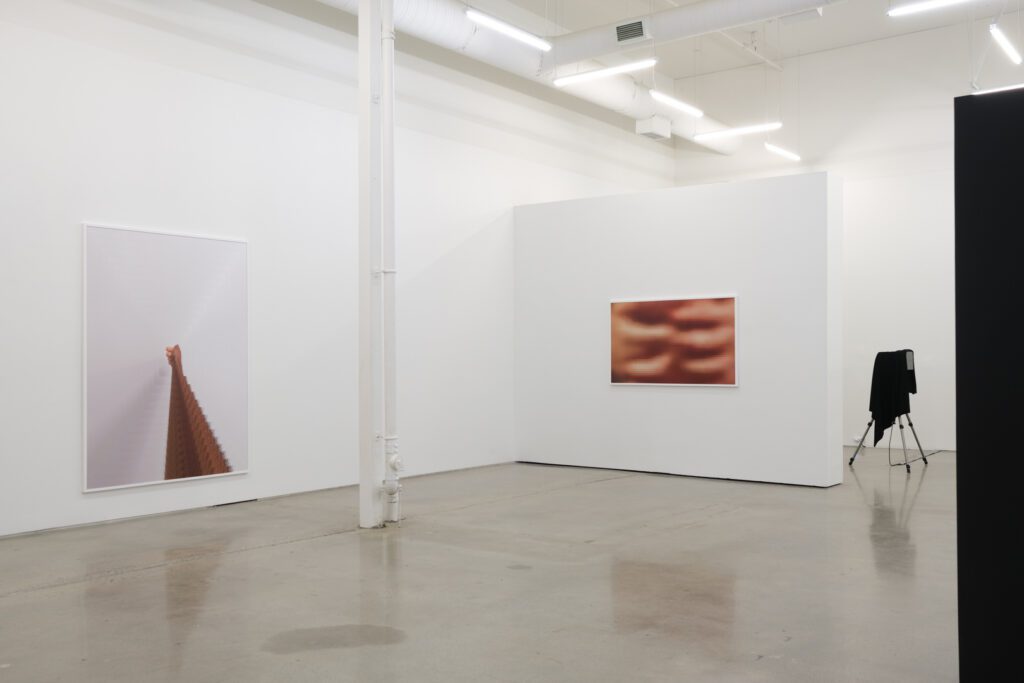
As a video essay, 10 + (-5) Commandments is fairly clear about the arguments it wants to make, and its stew of images, excerpts, and quotations also maps an intellectual (via Althusser, Badiou, Baudrillard, DeBord, Marx) and artistic (via Godard, Warhol, Pasolini, Manet, Courbet) genealogy of influences and fellow travelers. The argument being made here is that it is not that we see something, as say, an art historian might and then we say something about it, but rather that we are only able to see what can be described—or as the video would have it, what has already been said—in the ideologically conditioned language available to us, English, the language of contemporary art, as well as the dominant language under late-stage capitalism.
In other words, yes, the exhibition purports to take on the hegemony of the English language, but, more than that, also the ways in which capitalism structures what is possible to think and to perceive, let alone to do. Thus the crux of the exhibition’s argument seems to be: in the beginning was not the word, but the “economy of the word,” as the central video notes. However, “the real commandment,” one of the characters says (after-Althusser-after-Marx), “is the ideology of the reproduction of production.”
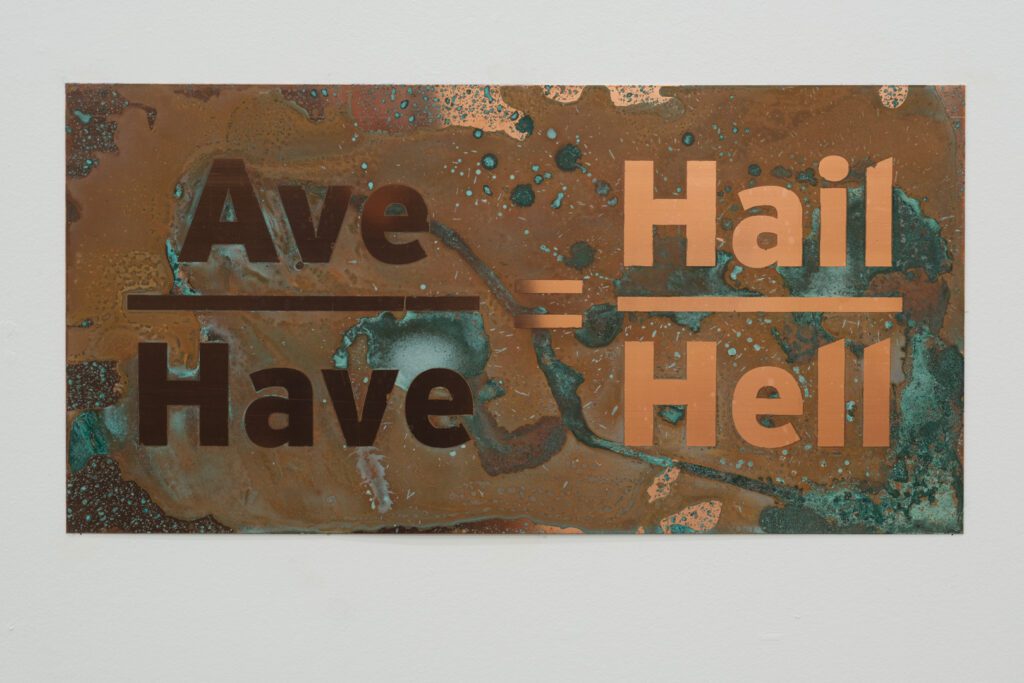
As any piece of contemporary critical art worth its salt, the video essay is both self-aware and self-referential.5 Scenes from the film essay Here and Elsewhere (1976) by Jean-Luc Godard and Anne-Marie Miéville, for example, perform the auto-critique of film’s (in)ability to portray reality. Another work called Ave is to Have as Hail is to Hell (2022), which references a Warhol piss painting (meets SAT test analogy), situates itself (and the exhibition) into an art historical lineage that is well aware of its position in the smoke-and-mirrors of the unregulated art market.
Or, is the piss painting just another of the show’s playground dick n’ ass jokes (e.g. images of “cock waffles,” or “cock hot dogs”). Ave is to Have as Hail is to Hell is easier to take seriously alongside works such as DynamicEquilibriumStaticEquilibrium (2022) which represents the administered nature of life via a diptych of a still image from Pasolini’s Salo or the 120 Days of Sodom and an image of anal sex-in-the-round, which was apparently taken from the Ottoman erotic manuscript Tuhfet Ul-Mulk. But the artists still can’t resist a comment like, “Capital functions like that, we often get it in the ass,” as one of the video’s narrators says. The video’s final scene is also the final commandment: AMASS.
The exhibition may depart from that which is ideologically fixed in language, thus what can be thought or seen or said, but by deploying various methods of slippage, of translation and pronunciation, of neighbour words, of pun, of joke, of the juxtapositions of montage, it is able to rent cracks in the smooth surface of the said. These slippages from word to world, from Godard to “good art,” echo the slippages of reference in the 10 + (-5) Commandments. The cut in reality that the technique of montage makes possible is not unrelated to the rupture produced by laughter, like when using humour as tactic.
If the video essay as a genre frequently can’t resist telling (say it) what it is also showing (see it)—though one or the other would suffice—this one can’t resist using English to do exactly that which it claims is impossible: using logic to understand the way things are (beneath what they appear to be), rather than the illogic that it suggests is the only way out of the conundrum in which we find ourselves as subjects under capitalism.
The tangle of references to the words have or hail, which in this context, calls to mind philosopher Louis Althusser’s notion of the hailing or interpellation of individuals as subjects. He writes that:
“The individual is interpellated as a (free) subject in order that he shall submit freely to the commandments of the Subject, i.e. in order that he shall (freely) accept his subjection, i.e. in order that he shall make the gestures and actions of his subjection ‘all by himself’.”6
“Just open your mouth and It will be said,” the narrator says.
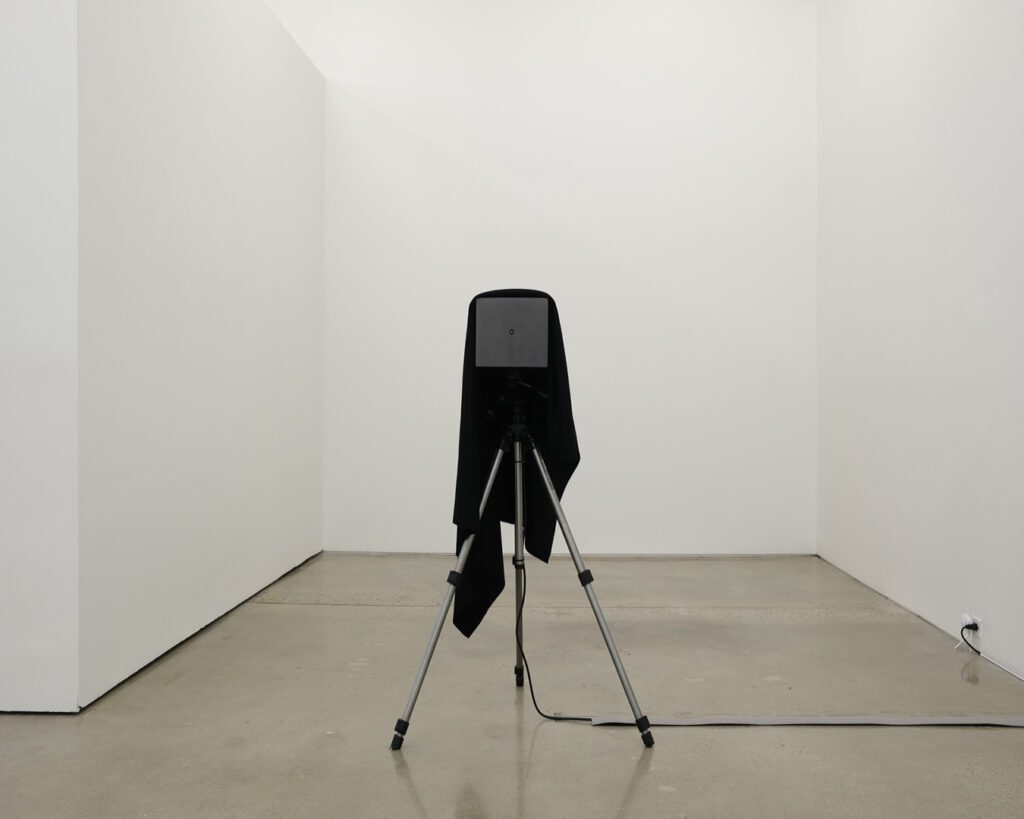
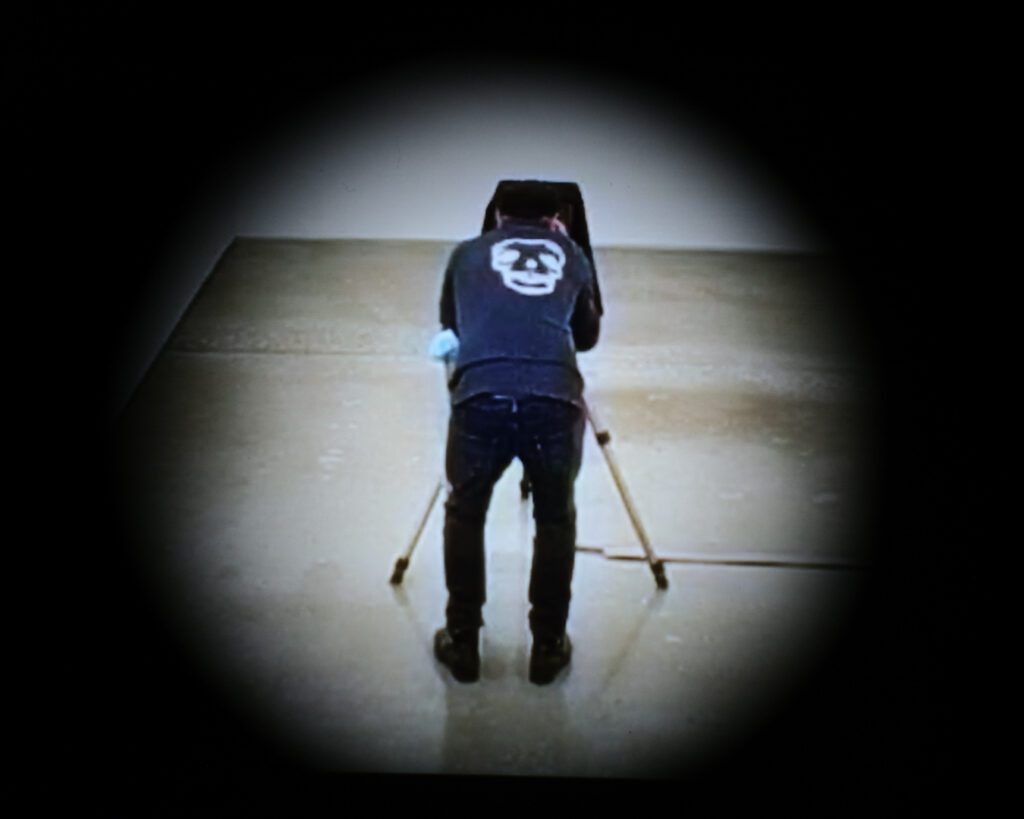
Images: Alibaba’s Perspective, 2022 by Alibaba Conundrum. Photos by Byron Dauncey courtesy of Griffin Art Projects.
In the final room of the exhibition, Alibaba’s Perspective (2022), a medium format camera on a tripod, sits in the middle of the room. When one bends to peer into the camera (gotcha!) the image is a live feed of the viewer’s own behind as captured by a camera installed high on the wall behind. In any other contemporary art exhibition shown in 2023, this piece would be referencing the ubiquitousness of surveillance cameras and our own self-surveillance practices via our smartphones. However, in Alibaba Conundrum, it’s both rimshot and invocation of the observation by the translator of Lacan’s The Other Side of Psychoanalysis. The word envers in French is not just the behind or other side of, but also the “the unseen, even the obscene” which “echoes Lacan’s claim that discourse makes visible only the measurable part of intersubjectivity.”7
Thus we wind through an illustration, a joke, a surprise, a cut, or a translation to get back where we started with language—and the impossibility of discourse even as it swims in the same. Which definition can we then confidently invoke that best describes this exhibition? Is the show’s conundrum “A riddle in which a fanciful question is answered by a pun?”; “A paradoxical, insoluble, or difficult problem; a dilemma?”; or “A conceit; a device; a hoax?”8 Or is it all of the above: fanciful punning conceit posing as a riddle that is actually a didactic device that may or may not have aspects of hoax—or at least a cavalcade of very smart in-jokes.
- https://en.wikipedia.org/wiki/Mission_Accomplished_speech
- CrimethInc, “Occupy: Democracy versus Autonomy,” CrimethInc.com, April 14, 2016, https://crimethinc.com/2016/04/14/occupy-democracy-versus-autonomy.
- https://en.wikipedia.org/wiki/Military%E2%80%93industrial_complex
- Dwight D. Eisenhower, “President Dwight D. Eisenhower’s Farewell Address (1961),” National Archives, The U.S. National Archives and Records Administration, last modified June 20, 2023. https://www.archives.gov/milestone-documents/president-dwight-d-eisenhowers-farewell-address#transcript.
- See: Robert Morris’ Box with the Sound of Its Own Making, 1961. https://www.metmuseum.org/art/collection/search/689665.
- Louis Althusser, Lenin and Philosophy and Other Essays, trans. Ben Brewster (New York: Monthly Review Press, 2001), 123.
- Eleanor Ivory Weber, “Sara Deraedt,” Afterall, September 15, 2020. https://www.afterall.org/article/sara-deraedt.
- The resulting first search results in Firefox running Duck Duck Go when searching for the definition of “conundrum” taken from the The American Heritage® Dictionary of the English Language, 5th Edition.
Alibaba Conundrum ran from February 11 – May 7, 2023 at Griffin Art Projects in North Vancouver, BC.
Feature Image: Something Axiomatic Here (and Elsewhere), 2021 by Alibaba Conundrum. Photo Byron Dauncey courtesy of the artists and Griffin Art Projects.



